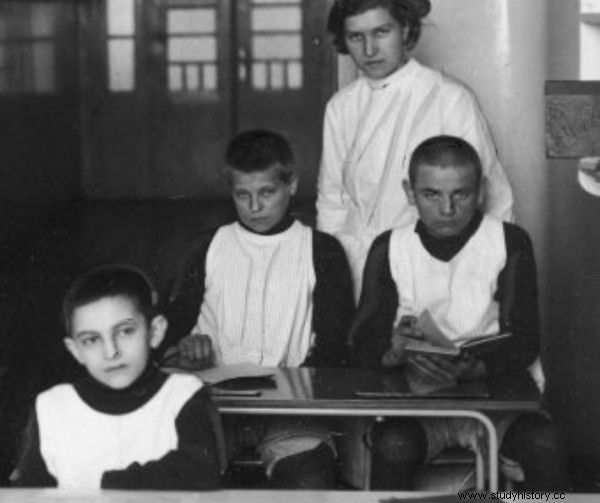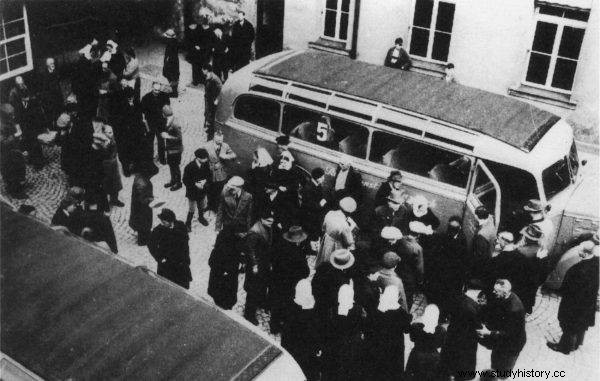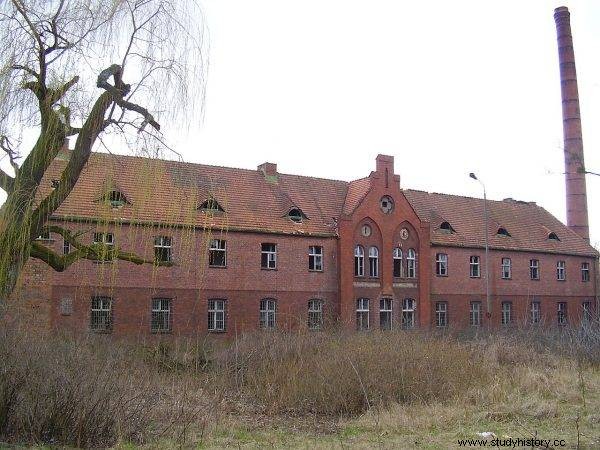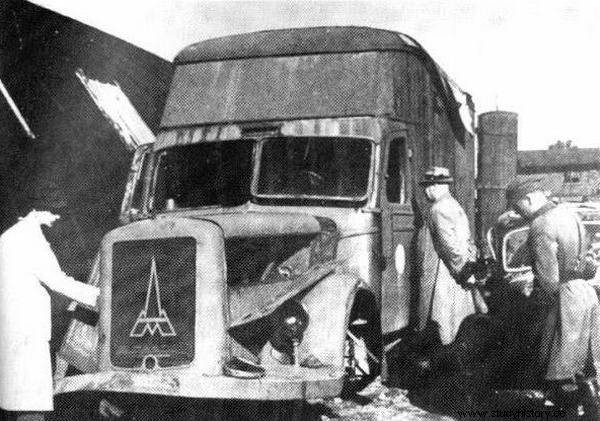Disabled children were taken to forests under the guise of "trips". Adults were murdered with wooden clubs or shot in the back of the head. Their only "crime" was that they were considered too imperfect to be allowed to live.
The extermination of people with intellectual disabilities began in the Third Reich before the outbreak of the war. In the first place, the criminal action involved German patients, especially disabled children. Over 70,000 people will be murdered in three years. Thus, Poles from the territories incorporated into the Reich as a result of the September campaign were almost immediately embraced by the criminal practice.
The occupation authorities got rid of Polish managers of psychiatric hospitals, replacing them with Germans. Some of the staff involved in caring for the sick were also dismissed, the use of drugs was reduced and there was a ban on exemptions from hospitals. Then lists of patients for "evacuation" were compiled.
I ordered sick people to get out one by one
The extermination of Polish disabled people was often carried out in the same places where victims of actions against our intelligentsia died. In the Szpęgawski Forest, the inmates of the psychiatric facility in Kocborów near Starogard Gdański were murdered. In numerous executions carried out from September to the end of 1939, over 1,200 patients were shot there. The German death machine was working very well in the early 1940s as well.
In January, about 700 patients of psychiatric institutions from Świecie nad Wisłą and Gniew were murdered in the same place. Among them, there were 120 disabled children who were taken to the forest under the guise of a trip. According to the reports of the execution witness, the little ones were released into the clearing and shot at them as if they were hunting game.

Little patients of the psychiatric facility in Chełm in the photo from 1936. For the German criminals, they were not "worthy to live".
More than 200 patients of the psychiatric hospital in Chojnice were shot about 1.5 kilometers from the city on the so-called Fields of Igielskie.
The method of eliminating the disabled was described by one of the torturers, SS-Sturmbannführer Kurt Eimann. His department carried out executions of patients of Pomeranian hospitals in the forests near Wielka Piaśnica.
The trucks drove away (...) about 50 meters from the execution site. I accompanied the transport. There I ordered the sick to get out one by one. Each time two SS men escorted the patient to the edge of the pit, the third followed him with the P08 pistol. At the edge of the pit, a third SS man shot the patient with a pistol in the neck so that he fell into the pit. This procedure was repeated one by one with all the sick from the transport. The platoon of three SS men changed all the time. As soon as a shot was fired, the next group was moving towards the pit.
There are reports of killing disabled Poles with wooden clubs on the banks of the death pits. People who gave signs of life were killed with small arms or covered with dirt to make them choke.
The victims' bodies convulsively twisted
In the Wartheland, the action of killing patients of psychiatric hospitals was carried out by a special unit of the Secret State Police "SS-Sonderkommando Lange", named after the commander, SS-Hauptsturmführer Herbert Lange. This formation was part of the already known Einsatzgruppe VI.
Extermination covered patients of institutions in Owińska near Poznań, Dziekanka near Gniezno, Kościan, Kochanówek near Łódź, Warta, Gostynin, patients of the hospital in the ghetto in Łódź and social care institutions in Bojanów, Osieczna and Śrem.

As part of Operation T4, tens of thousands of citizens of the Third Reich were murdered. A similar fate awaited Poles with physical and mental disabilities. Photo and caption from the book "Balance of harms".
About 1,000 patients of the hospital in Owińska were liquidated first. They were taken to a concentration camp organized by the Germans in Fort VII in Poznań, where there was a makeshift gas chamber. The removal of the inmates from the premises of the facility was accompanied by the crying and terror of the sick, as well as brutal, guttural shouts of the SS men who supervised the whole process.
One of the Polish nurses recalled it like this:
In the barrack there were infirm, often unable to walk, they had to be brought to the car. By the car, the sick were picked up by soldiers in SS uniforms (...) who even threw the sick into the car, not taking into account the fact that the sick could suffer damage or cut themselves. (...) I saw the children taken away. The youngest children were taken out of the unit in a laundry basket, the SS men threw them into the car.
The Polish doctor Zdzisław Jaroszewski remembered the "evacuation" of the facility in a similar way:
Children were the last batch. More often than not, the crying ones were torn from the hands of the nurses and thrown into the carriages without the slightest consideration, children's hands and feet fell out through the gaps in the cars, to which the SS men did not pay any attention .
Disabled people were transported on tarpaulin-covered lorries. Previously, they were instructed to change into normal clothes so that they would not be visible to outside observers due to the hospital clothes.

It was in this building that a psychiatric facility in Owińska was located before the war.
The gas chamber located in one of the Fort VII bunkers could accommodate up to 50 people. The disabled were brought into the room by Polish prisoners in the fort, then they sealed the door with clay, and the SS man on duty opened the valve of the carbon monoxide cylinder, which was forced into the bunker by a metal pipe. Inside such a chamber there were usually inhuman scenes:
People (…) were panicking. The injection of the odorless, invisible gas instinctively disturbed them. Carbon monoxide was running without warning. Almost no one knew what was happening. Some fought, screamed in panic. They pushed to the exit and pounded on the door with their fists. Then a slow suffocation followed. Locked in the chamber, they gasped for air.
Each of the victims had similar symptoms:the heart began to pound, the blood pulsed in the temples, the headache increased, dizziness began, vision became blurry. It all happened in a matter of minutes:muscles refused to obey, limbs showed signs of paralysis, carbon monoxide blocked the absorption of oxygen in the blood, and finally the body weakened. The bodies of the victims twisted convulsively in the final paroxysm of deadly combat. The gas chamber was littered with excrement and vomit .
In some cases, before gassing, German doctors administered sedatives to the disabled. As a result, they were passively and apathetic to their fate.
"Kaiser's Kaffee-Geschäft"
Then it was the turn of the extermination of the patients of the hospital in Dziekanka. The history of their extermination is associated with the shameful attitude of the then Polish director of this department, Dr. Wiktor Ratka. Signing the Volkslist allowed him to stay in the position. Ratka then revealed his two-faced character. Not only did he harass his former subordinates, making them understand at every step that they were undesirable in the hospital, but also personally indicated patients to be killed. Later, he joined the SA and the NSDAP and became one of the experts on action "T4" at the Berlin headquarters at Tiergartenstrasse.
The torturers from the death commando of SS-Hauptsturmführer Lange tested a new method of killing on the handicapped inmates of Dziekanka. They used mobile gas chambers for this. They were specially constructed trucks, the so-called Sonderwagen, resembling furniture cars. Their rear loading part was covered with a brass sheet inside, sealed with felt and equipped with an installation for supplying carbon monoxide from the cylinder.
This significantly shortened the "disinfection" process as the sick were simply killed on their way from the hospital to the burial site. The gas chamber cars were marked similarly to the cars of one of the grocery store chains. They had the words "Kaiser's Kaffee-Geschäft" painted on the sides.
In later years, after the invasion of the Soviet Union, the Germans significantly simplified the construction of mobile gas chambers. People were killed no longer with carbon monoxide, but with exhaust gases, which was led through a conduit connected to the end of the exhaust pipe. It was a cheaper solution, but no less effective and cruel.
Between December 7, 1939 and January 12, 1940, 1043 mentally disabled patients of the hospital in Dziekanka were killed. Their bodies were buried in the forests near Gniezno. The Polish medical staff managed to, risking their own lives, save a dozen or so patients, including people of German origin, who were secretly sent back to their families.
Patients "with no chance of recovery"
On January 15, 1940, the drama of Polish patients from the hospital in Kościan began, which was emptied within a week, the patients were taken away in the masked trucks mentioned above. Ruthless SS men crammed as many as 75 people into one of the vehicles. The sick lay there one on top of the other. The bodies of 532 gassed patients were buried in the graves in the forest between Jarogniewice and Głuchów and in the forest near Stęszewo. Later, 2,750 patients from the Reich were sent to the hospital in Kościan. They were all murdered.

German mobile gas chamber in the photo taken after the end of the war.
The hospital for the mentally ill in Warta was considered to be one of the best and most modern facilities of this type in pre-war Poland. This was due to the hard work of Dr. Karol Szymanski, who was mobilized after the outbreak of the war as a second lieutenant in the Polish Army, and was later exterminated in the spring of 1940 in Katyn. Between April 2 and 4, 1940, Lange's SS men murdered 499 of his patients. The sick, as if sensing what awaited them, scattered around the hospital grounds, and the perpetrators had a much more difficult task. The bodies of 201 men and 298 women were buried in the forest near Rososzyca.
The last facility visited by Lange's wetboys was the hospital in Gostynin. Until June 1940, the SS men shot 48 patients staying there, and on June 9 they deported 29 women and 39 men using a mobile gas chamber. It is worth mentioning here the steadfast attitude of the Polish deputy director of the hospital in Gostynin, doctor Karol Mikulski. With the outbreak of the war, he was mobilized into the army as a second lieutenant. After the Soviets attacked Poland, he was taken prisoner. Fortunately, he managed to escape from the railway transport to the POW camp in Kozielsk. After returning to Gostynin, in October 1939, he resumed his function in the hospital.
On March 17, 1940, a German commission appeared with Dr. Mikulski, instructing him to select patients who had no chance of recovery within 24 hours. Doctor Mikulski knew exactly what it meant - rumors of murders of Polish disabled people reached Gostynin. Mindful of medical ethics, not wanting to lend a hand to the killing of his charges, he committed suicide the next morning. The Germans did not receive the sick lists, and the death of Dr. Mikulski for some time stopped the extermination of the patients of the hospital in Gostynin.
Bibliography
The article is an excerpt from the book by Dariusz Kaliński entitled "Balance of harms. What did the German occupation of Poland really look like "
